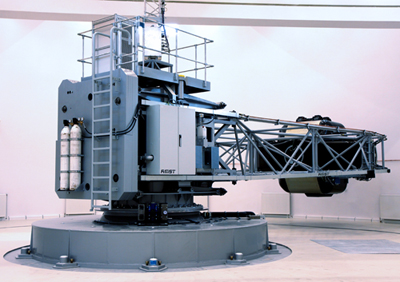
The Dynamic Flight Simulator (DFS) that is, in fact, one of the crucial functions of the Polish Human Training Centrifuge gives plenty of opportunities for using it in operational, training and diagnostic character. It allows to perform intensive pilot training providing to proper performance of anti-G maneuvers and familiarisation of aircrews with effects of activity of high accelerations with longitudinal time and push-pull phenomena. Moreover the centrifuge provides a safe alternative to raise awareness of aircrews in case of possibilities unwanted effects of accelerations, such as G-LOC loss of consciousness or spatial disorientation. Centrifugal training allows to restore and/or maintain optimal G-tolerance even performing of tasks in the air is impossible or not required. Costs of such training are definitely much lower than possible costs of using modern combat aircrafts and not even mention about human life.
The gondola of the centrifuge has been assembled on eight-meter-long arm and allows to achieve Z-axis accelerations in the range from –3G to +16G with maximal gradient of accelerations increasing to 14,5 G/s. Additionally gyroscopic suspension of the gondola provides to achieve X-axis and Y-axis accelerations respectively in the range of the value ± 10G and ± 6G.
The human centrifuge is dedicated for survey and training of candidates for military pilots and pilots flying on highly-maneuvering aircrafts (i.e. combat, acrobatic and sport), and experimental technical tests.
Interchangeable parts of the centrifuge gondola enable functional projection cockpit equipment of the Polish Air Force basic multi-purpose aircrafts i.e. F-16 Block 52+ and MiG-29.
TRAINING CAPABILITIES
- pre-startup activities,
- flights under instruments and navigation (navigation by VOR, VOR/DME, TACAN and NDB, radio procedures – communication equipment maintenance, procedures for flights at night, approach controlled from the Earth, approach to landing by ILS, group flights and navigation in difficult weather conditions),
- outputting of the aircraft from unusual locations,
- emergency situations (fire engine, damage of the control system, etc.),
- combat application (intercept of air targets, defensive maneuvers, use of weapons, etc.),
- training Spatial Disorientation (SD) consist of:
- black hole approach,
- false horizon,
- pitch up illusion,
- runway illusions,
- autokinesis,
- oculogravic,
- false horizon night,
- G-excess,
- graveyard Spin,
- vection Illusion,
- flight at night condition with Night Vision Goggles (NVG).
POSSIBLE TASKS
- Aircrew pre-selection, evaluation of individual natural G-tolerance,
- High-G training to recognize individual symptoms of high-G stress and G-tolerance limits,
- Teaching and training of effective anti-G measures (breathing methods, anti-G straining maneuvers) and the optimal individual use of the G-protection equipment,
- Improving aircrew tolerance to high-G stress,
- Improving G-awareness of aircrew,
- Standardized high-G training of aircrew for high-performance aircraft using pre-programmed standard profiles (STANAG 3827),
- Annual validation, conditioning and refresher training of experienced aircrew,
- Pilot-in-the-loop training in active closed-loop mode,
- DFS with simulated aircraft in active closed-loop mode,
- Physiological research and specific investigations of aviation-medical problems,
- Equipment testing and assessment of ergonomic aspects of high-G flight.
Moreover possibility of the human centrifuge use for diagnostics allows in comprehensive way to assess the pilot’s physical fitness in environment of real gravitational loads. Possession of the centrifuge with such high parameters will allow to conduct medical research on ways of pilots protection against high and rapidly increasing accelerations. The centrifuge has also large developing potential to conduct additional psychological tests aimed to understand and analyze the pilots behavior subjected the accelerations.
TECHNICAL PERFORMANCE CHARACTERISTICS
- main arm length: 8 m,
- gondola payload: 250 kg and 350 kg in the experimental configuration,
- cross section point (3 axes): head level,
- Gz acceleration range from -3 G to +16 G,
- Gy acceleration range from -6 G to +6 G,
- Gx acceleration range from -10 G to +10 G,
- Roll and pitch angle: ±360°,
- max. roll and pitch angular acceleration: 8 rad/s2.
DYNAMIC FLIGHT SIMULATION (DFS)
The high-performance training centrifuge, equipped with advanced motion control, is capable of performing dynamic closed-loop operation and generating a realistic simulation of natural high-G environment (sustained G-forces) as it occurs in real flight.
The centrifuge DFS is capable of providing realistic task loading and mission stress for several DFS training tasks:
- G-awareness training in closed-loop mode using simulated aircraft configuration,
- Target tracking,
- Simulation of typical combat and missile avoidance manoeuvres,
- Execution of tactical tasks in high-G environmen.
DFS CONFIGURATION
Software
- Aircraft simulation model (Mig-29, F-16),
- Centrifuge DFS control software with motion filter,
- Aircraft flight instruments and avionics,
- OTW visual system software (terrain database, target aircraft),
- DFS operational software.
Hardware
- Aircraft cockpit mock-up, instrument front and side panels,
- Adjustable seat,
- Head-Up Display,
- OTW visual system (120 vertical x 70 horizontal field of view, resolution of the projector 1920 x 1080 pixel),
- Aircraft controls (typical force characteristics, grips and switches),
- Anti-G system (aircraft standard equipment, software-controlled anti-G valve),
- DFS control station.
MEDICAL MONITORING SYSTEM
Based on digital PCM transmission technology and using state-of-the art sensor and amplifier technology, typical biomedical parameters can be measured and recorded:
- ECG,
- ENG,
- EMG,
- heart rate,
- auricular pulse,
- body temperature,
- blood pressure (NIBP),
- oxygen saturation,
- breathing frequency,
- breathing volume,
- possible to measure and record: EEG, etc.
| Contact: | MD PhD Krzysztof Kowalczuk phone: +48 261 852 000 e-mail: kkowalczuk@wiml.waw.pl |


